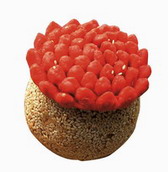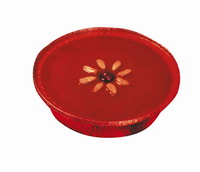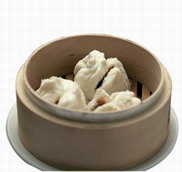
Feature Articles
(I) Food Safety Day
.jpg)
There is a Chinese saying that "food is people's paramount concern". When enjoying food, we should pay attention to food safety in order to prevent the spread of disease. Every summer, the Centre for Food Safety (CFS) organises a series of large-scale promotional activities to advocate food safety.
.jpg)
.jpg)
The theme of this year is "Five Keys to Food Safety". The campaign was kicked off by the "Food Safety Day 2008" jointly organised by CFS and Radio 1 of the Radio Television Hong Kong on 29 June 2008 at Tuen Mun Town Plaza. Mr. CHEUK Wing-hing, the Director of Food and Environmental Hygiene, officiated at the opening ceremony. Other officiating guests included Mr. CHEUNG Yu-yan, the Chairman of the Legislative Council Panel on Food Safety and Environmental Hygiene, Dr. CHAN Hon-yee, the Controller of the Centre for Food Safety, Mr. CHAN Yiu-wah, the Head of Radio 1 of the Radio Television Hong Kong, Professor KWAN Hoi-shan, the Chairman of the Expert Committee on Food Safety, Ms LAM Yuen-mui, the Acting Chief Executive of the Consumer Council, Mr. CHAN Wing-on, the Chairman of the Hong Kong Federation of Restaurants and Related Trades, Mr. YEUNG Wai-sing, the Chairman of the Association for Hong Kong Catering Services Management Ltd, Mr. WU Chu, the Vice-Chairman of the Hong Kong Catering Industry Association, Mr. Ronald LAU Yiu-fai, the President of the Hong Kong Food Council, and Mr. Albert CHAN, the Chairman of the Hong Kong Food & Science Technology Association.
"Five Keys to Food Safety" are "Choose" (choose safe raw materials), "Clean" (keep hands and utensils clean), "Separate" (separate raw and cooked food), "Cook" (cook thoroughly) and "Safe temperature" (keep food at safe temperature). Exhibition panels and game booths were set to help enhance people's awareness of the "Five Keys to Food Safety".
Artistes including Mr. Harry WONG, Ms. LAU Yuk-chui, Mr. Micheal CHENG, Ms. Fiona SIT, Ms. Kay TSE, Ms. Keeva MAK, Ms. Bianca WU, Ms. Ella KOON, Mr. CHAU Pak-ho, Ms. Stephanie CHENG, etc. were invited to give performances, such as magic shows, games and dramas, to promote the food safety message. The function was well received with more than 3,000 members of the public attending. About 18,000 publicity pamphlets and 5,000 souvenirs were distributed that day.
.jpg)
.jpg)
.jpg)
.jpg)
.jpg)
Press1.jpg)
II) Food Safety Charter
.jpg)
.jpg)
The Centre for Food Safety (CFS) has all along been promoting the importance of tripartite collaboration among the Government, the food trade and consumers to ensure that food sold in Hong Kong is safe and fit for human consumption. To highlight the theme of "Five Keys to Food Safety" this year, CFS has invited representatives of the food trade to sign the "Food Safety Charter". Upon signing the "Food Safety Charter", food trade associations and restaurants are committed to disseminating the messages of the "Five Keys to Food Safety" to their staff, members and customers, as well as to set a good example for the trade so as to uphold the food safety standard.

The "Food Safety Charter" signing ceremony was held on 3 July 2008. More than 70 representatives from food trade associations and licensed food premises who were members of the associations signed the "Food Safety Charter". The ceremony was witnessed by Mr CHEUK Wing-hing, the Director of Food and Environmental Hygiene, Mr CHEUNG Yu-yan, the Chairman of the Legislative Council Panel on Food Safety and Environmental Hygiene and Mr LI Wah-ming, the Deputy Chairman, Dr CHAN Hon-yee, the Controller of the Centre for Food Safety, Professor KWAN Hoi-shan, the Chairman of the Expert Committee on Food Safety and Mr Kenneth SO, the Head of Public Affairs Division of the Consumer Council. Addressing the ceremony, Mr CHEUK said that the trade had been playing a vital role in ensuring food safety by attending to every step of storage, processing and delivery of food from raw materials to end products. He thanked the trade for their enthusiastic support for the Charter and joining with the public and the Government in promoting and implementing measures to ensure food safety.
In addition to food trade associations and their members, CFS also invited other licensed food premises at the end of July to join the Government and consumers in building a food safe city by signing the "Food Safety Charter".
As at early September, a total of 20 food trade associations and more than 700 licensed food premises have signed the Charter. Licensed food premises signing the Charter are required to display the "Food Safety Charter" certificate and posters on "Five Keys to Food Safety" in their food premises. Members of the public are welcome to visit the designated "Food Safety Charter" web site of CFS to browse the signatory list for licensed food premises.
(III) Web page of the Centre for Food Safety – Consumer Zone
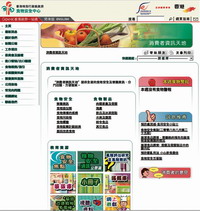
To facilitate consumers to search for information on food safety in our web page, we have introduced a "Consumer Zone", featuring "Food Safety", "Food Product" and "Educational Resources" as three main headings incorporating relevant information of interest. With the enhancement of search function, consumers can get the information they need more easily.
"Food Safety" covers subjects which attract wide concern, for example, food labels and nutrition information on prepackaged food products, trans fat, and microbiological and chemical test results of certain commonly consumed food such as street snacks.
In "Food Product", foods are classified into different categories to facilitate the location of health information on various foods.
"Educational Resources" comprises electronic publications, printed materials, audio-visual resources as well as online games. The public will find it very convenient to obtain the information they need in the same platform.
The contents of "Food Alert This Week" and "Recommendations" in this new web page will be updated periodically, providing the latest news and publications in detail. The public can also give us their comments in "Consumer Feedback".
For access to this new and exciting web page, please visit the following web site: http://www.cfs.gov.hk/english/consumer_zone/consumer_zone.html
Readers' Corner
(I) Microbiological Quality of Lunch Boxes
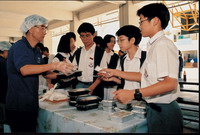
To assess the microbiological quality of lunch boxes, CFS conducted a targeted food surveillance from April to May this year, and collected 300 samples of lunch boxes from food factories and restaurants for microbiological testing. Pathogens tested include Salmonella spp., Staphylococcus aureus, Clostridium perfringens and Bacillus cereus. Among these samples, two were found to be unsatisfactory.
They contained the pathogen Bacillus cereus at levels classified as "unacceptable" under the "Microbiological Guidelines for Ready-to-eat Food." As this will cause health risks to consumers, CFS has issued warnings to the premises concerned and stepped up inspection.
Advice for consumers:
- Purchase lunch boxes from hygienic and reliable sources;
- Wash hands thoroughly before and after meal;
- Consume the lunch boxes as soon as possible; and
- Do not consume if abnormalities are detected.
(II) Five Keys to Enjoy a Safe Buffet
To meet customers' demand, many restaurants serve buffets which offer a wide variety of foods including not only traditional cooked foods, but also high risk foods such as raw oyster and sashimi. In selecting buffet foods, the public should be extra vigilant and follow the "Five Keys to Food Safety" to ensure food safety and prevent food poisoning.
Choose
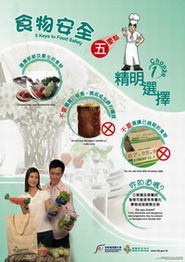
- Patronise licensed restaurants with a good reputation. Before choosing a restaurant, take a look at its hygienic conditions.
- Pay attention to the freshness of the food. Do not consume food that tastes abnormal.
Clean
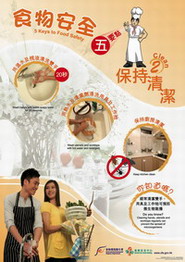
- See whether the restaurant staff practice good personal hygiene and whether food is handled in a hygienic way.
- Check whether the utensils provided by the restaurant are hygienic.
- Use a clean plate to take food each time. Do not use the same plate repeatedly.
- Wash hands with warm soapy water before getting food from the buffet tables and before consumption.
Separate
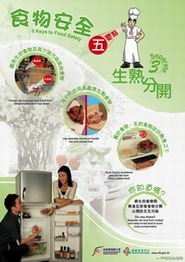
- Use separate utensils such as tongs and plates provided by the restaurant to pick raw and cooked foods to avoid cross-contamination.
Cook
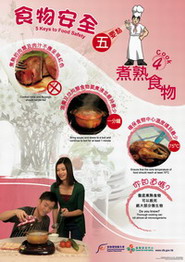
- When consuming meat and poultry, make sure that their juices are clear and not red; blood is not visible when you cut the cooked meat.
Safe Temperature
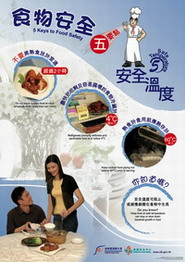
- Select cold dishes kept in fridges or on ice.
- Choose hot dishes kept in warming devices.
- Do not take too much food at one time to avoid prolonged exposure of the food at room temperature.
Lastly, the elderly, children, pregnant women and people with lower immunity should avoid consuming high risk foods like raw foods or cold dishes.
(III) Nitrate in Food

The media reported an incident that the skin of a nine-month-old baby boy turned blue after consumption of congee containing Chinese spinach. He was confirmed to suffer from Blue Baby Syndrome, i.e. methaemoglobinaemia, which is a rare condition under which haemoglobin in the blood has been oxidized to methaemoglobin and is unable to carry oxygen to the body tissues. Subsequent testing of the congee sample confirmed the presence of high nitrate content which could well be converted to nitrite in the baby boy causing the methaemoglobinaemia.
Nitrate occurs in the environment, in air, food (particularly in vegetables and fruits) and water, and is produced inside living organisms. It can also be used as preservatives, mainly in cheese products and cured meat (e.g. preserved sausage and ham). The level of nitrates in vegetables varies greatly among species. Higher levels of nitrate have been consistently reported in certain vegetables. However, the content of nitrate in food is generally safe for adult consumption.
Vegetables are important to human nutrition as a source of dietary fibre, vitamins and minerals and can help prevent the development of cancers and other chronic diseases. The public are advised to maintain a balanced diet and eat a variety of fruits and vegetables (i.e. leafy vegetables, fruiting vegetables, root vegetables, flowering/head brassicas etc. on different days) in order to avoid excessive exposure to chemicals from a small range of food.
Babies below 6 months of age are most vulnerable to methaemoglobinaemia and should avoid vegetables of high nitrate content (e.g. spinach, beets) and processed food with nitrates added as food additives (e.g. cheese, cured meats).
Advice to the Public
- Maintain a balanced diet. Avoid overindulgence of food items.
- To reduce the health risk of nitrate due to consumption of vegetables, members of the public can
- keep the vegetables under refrigeration;
- wash, peel, remove the stem, blanch the vegetables before cooking, when appropriate; and
- cook vegetables soon after cutting or mashing.
Babies below 6 months of age are most vulnerable to methaemoglobinaemia and should avoid vegetables of high nitrate content (e.g. spinach, beets) and processed food with nitrates added as food additives (e.g. cheese, cured meats).
Advice to the Public
- Maintain a balanced diet. Avoid overindulgence of food items.
- To reduce the health risk of nitrate due to consumption of vegetables, members of the public can
- keep the vegetables under refrigeration;
- wash , peel, remove the stem, blanch the vegetables before cooking, when appropriate ; and
- cook vegetables soon after cutting or mashing.
(IV) Watercress and Parasitic Infestation
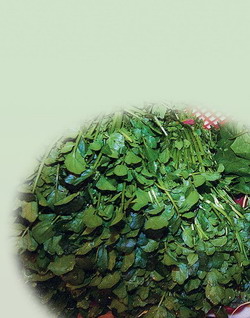
Recent newspapers reported that a local woman was infested by the parasitic liver fluke Fasciola after consuming raw watercress during her travel in Southeast Asia. Fascioliasis is an infection caused by Fasciola hepatica (the cattle/sheep liver fluke) or Fasciola gigantica. Humans are highly prone to infestation after eating uncooked water plants like watercress, which provide shelter for liver flukes. They can cause damage and enlargement of the liver during early stage of infestation, and can later cause severe pain in the right upper abdomen or yellowing of skin, and in some cases, skin inflammation. To prevent parasitic infestations, do not consume uncooked water plants, particularly watercress and water chestnuts.
Food News
Comparisons between Saturated Fat and Trans Fat
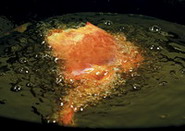
You probably have already known about saturated fat and its harmful effects on human health, particularly the risk of heart disease. In recent years, another type of fat, trans fat, has increasingly become a subject of concern both overseas and in Hong Kong . So what are the differences between these two types of fat? Which one is more damaging to our health? Please take a look at the following table and you will get the answers.


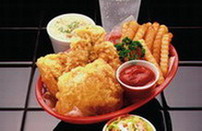
| Saturated Fat | Trans Fat | |
|---|---|---|
| Sources |
|
|
| Daily Intake Goal |
|
|
| Health Effects |
|
|
As part of a healthy diet, it is advisable to choose foods low in both trans fat and saturated fat.
Food Safety Plan Corner
Critical Control Points of Preparing Stir-fried Beef with Rice Noodles
What comes to your mind at the mention of beef and rice noodles? Stir-fried beef with rice noodles, of course. This is a Hong Kong specialty dish that we would choose when eating out, and many people would prepare at home for their families. The dish may appear to be simple, yet w hen preparing this dish, attention must be paid to some critical points on safety. We provide some safe cooking tips for you so that your family can enjoy this delicious dish safely.
| Ingredients | |
|---|---|
| Rice noodles | 300 grams (about 8 taels) |
| Fresh Beef | 150 grams (about 4 taels) |
| Bean Sprouts | 50 grams |
| Blanching chive | 50 grams |
| Seasonings | |
|---|---|
| Oyster sauce | 2 tablespoons |
| Sesame oil | 1 teaspoon |
| Corn starch | 1 teaspoon |
| Dark soy sauce | 1 tablespoon |
| Light soy sauce | 1/2 tablespoon |
| Cooking oil | 2 tablespoons |
Steps:
- Slice the beef and marinate it with oyster sauce, sesame oil and corn starch for 15 minutes.
- Cut the blanching chives into several parts.
- After cooking the bean sprouts in boiling water, place them in a container to drain off the water.
- Pour 2 tablespoons of oil and put the marinated beef into the wok after preheating. When the beef is fully cooked by stir-frying, add rice noodles, blanching chives, bean sprouts, light soy sauce and dark soy sauce. Stir-fry evenly until they are thoroughly heated.
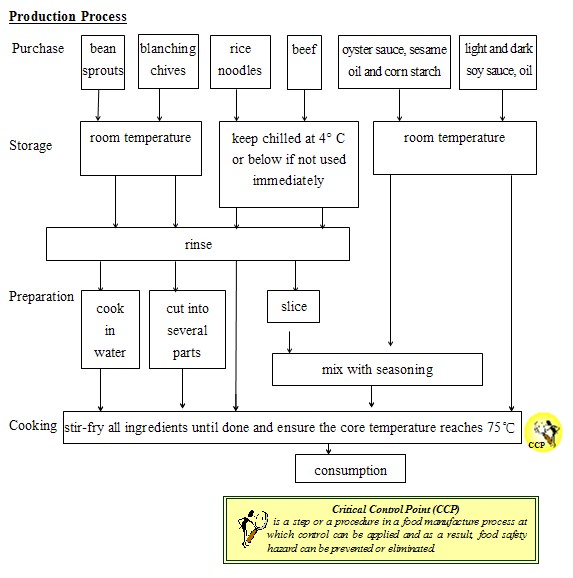
Safety Tips on Production of Stir-fried Beef with Rice Noodles
- Purchase
- Purchase the ingredients from reliable and hygienic shops.
- When buying the ingredients, make sure that
- the food is fresh and wholesome;
- the beef is purchased from a licensed "Fresh Provision Shop";
- all pre-packaged food items (e.g. oil and corn starch) are used before the expiry date.
- Storage
- Store the ingredients immediately at safe temperature.
- Raw beef and rice noodles not for immediate use should be stored in the refrigerator. The temperature inside the refrigerator should be checked regularly with a thermometer to ensure that the fridge remains at 4 oC or below.
- Raw beef should be stored in a container with a lid, and put under cooked food or ready-to-eat food to prevent cross contamination.
- Practise the first-in-first-out principle for storage.
- Store the ingredients immediately at safe temperature.
- Preparation
- Before cooking, wash all food contact surfaces (including worktops, chopping boards and cooking utensils) thoroughly.
- Before cooking / in the course of preparing food, wash hands thoroughly with warm water and liquid soap.
- Use two different sets of utensils (including knives, chopping boards, bowls and chopsticks) to handle raw and cooked food separately.
- Rinse rice noodles, beef, bean sprouts and blanching chives before cooking.
- Marinated beef not for immediate cooking should be stored in the refrigerator at 4 oC or below.
- Cooking
- Cook food thoroughly before consumption. The beef should be thoroughly cooked until the meat juice becomes clear and not red.
- Use a clean food thermometer to measure the core temperature of food, which should reach at least 75 oC.

- Consumption
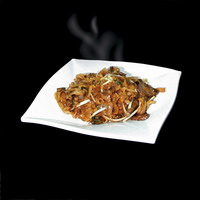 The cooked food should be consumed as soon as possible. It should not be kept at room temperature for more than two hours.
The cooked food should be consumed as soon as possible. It should not be kept at room temperature for more than two hours.
Briefing of Activities
(I) Promoting "Five Keys to Food Safety" in Food Expo 2008
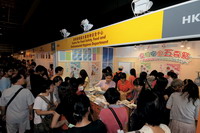
There are so many events not to be missed this summer! Besides the 2008 Olympic and Paralympic Equestrian Events hosted by Hong Kong, the Food Expo 2008 organised by the Hong Kong Trade Development Council from 14 to 18 August 2008 brought together food manufacturers and suppliers from Hong Kong, the Mainland and overseas countries, which offered a wide range of food and drinks to the public. To remind the public of food safety and hygiene while enjoying the great food, CFS set up a booth at the Expo to promote the "Five Keys to Food Safety" through games and exhibitions. Members of the public were advised to follow the "Five Keys to Food Safety" to ensure food safety.

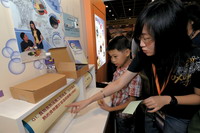

(II) Consumer Liaison Group
The Consumer Liaison Group (CLG) provides a platform for the Centre for Food Safety (CFS) to communicate with the public on various food safety issues so as to collect suggestions and comments from them. By understanding public's knowledge, beliefs and risk perception on various food safety issues, tailored risk communication messages can be developed to meet their needs.
In the past two years, a total of 16 CLG meetings were held. Members' active participation and valuable opinions are greatly appreciated. The enrolment of the new term of CLG was completed and over 260 members have been enrolled. A certificate presentation ceremony was held on 23 August with Dr CHAN Hon-yee, the Controller of the Centre for Food Safety, as the officiating guest. Many CLG members attended the ceremony and they discussed and exchanged their views on topics related to food safety.
Legal Corner
(I) Harmful Substances in Food Regulations

The Harmful Substances in Food Regulations (the "Regulations"), subsidiary legislation of the Public Health and Municipal Services Ordinance (Cap. 132), regulate harmful substances in food. The Regulations set out the maximum concentration of harmful substances in food and the substances prohibited for use in food. Any person who contravenes the Regulations is liable to a maximum fine of $50,000, imprisonment for 6 months and suspension of his food business licence.
The Regulations stipulate that the maximum permitted concentration of aflatoxin in peanut products and other food products are 20 and 15 micrograms per kilogram of the food respectively. Traces of aflatoxin may be found in food and long term intake may cause liver cancer.
In addition, the Regulations stipulate that clenbuterol is a prohibited substance. Selling pork and pig offal containing clenbuterol (a leanness-enhancing agent) is in breach of the Regulations. Consumption of clenbuterol tainted pig offal and pork may cause symptoms like dizziness, headache, hand tremor, palpitation and agitation. People with heart diseases are prone to more severe effects.
(II) Colouring Matter in Food (Amendment) Regulations 2008
Red 2G (also known as CI Food Red 10, International Numbering System No.128) is a synthetic dye which is resistant to heat, light, acids and sulphur dioxide. It imparts a light red colour, producing cherry to blood-red shades in foods. The European Food Safety Authority (EFSA) has recently re-evaluated the safety of Red 2G and concluded that the use of Red 2G in food would pose a safety concern.
Red 2G is converted into aniline in the human body and experts consider that aniline could possibly be carcinogenic. In the light of this, Hong Kong will ban the use of Red 2G as a colouring matter in food. The amended Colouring Matter in Food Regulations shall come into effect on 1 December 2008 .
